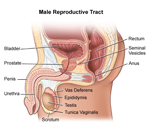September is Prostate Cancer Awareness Month
Prostate cancer is the second leading cause of cancer death in men in the US
Sep 1, 2012
NEW YORK
What is Prostate Cancer?
Prostate cancer describes cancers that start in the prostate – a male gland about the size of a walnut found near the rectum and under the bladder. The prostate makes a cushioning fluid for sperm cells in semen. In most cases, prostate cancer – which affects only men – develops slowly over many years, often so slowly that the best treatment is simply watching and waiting.
Know the Facts
Consider these statistics from the American Cancer Society:
- Approximately one in six men will be diagnosed with prostate cancer in his lifetime. Tweet
- More than 90 percent of all prostate cancers are discovered while they are either localized (confined to the prostate) or regional (nearby). The five-year survival rate for men diagnosed with prostate tumors discovered at these stages is nearly 100 percent. Tweet
- In 2012, 28,170 deaths are estimated to occur from prostate cancer in the U.S. alone, making it the second leading cause of cancer death in men. Tweet
To Screen or Not to Screen: The Debate Over PSA
There is no doubt that testing for PSA (prostate-specific antigen, a marker of prostate cancer growth) has helped increase the number of prostate cancers that are detected in their early, most curable stages.
This past May, the U.S. Preventive Services Task Force recommended against the use of PSA testing to screen for prostate cancer, stating that the science shows that "more men will be harmed by PSA screening than will benefit."
Our physicians, Edward P. Gelmann, M.D. and Ashutosh K. Tewari, M.D. offer their opinions
How Can Men Reduce Their Risk of Prostate Cancer?
The biggest risk factor for prostate cancer is age, followed by race, nationality, family history and genes.
Age Prostate cancer is rare in men younger than 40, but the frequency increases dramatically over the age of 50. Over 60 percent of prostate cancers are found in men over 65.
Race Prostate cancer is statistically most prevalent in African-American men, followed by Caucasian men, Asian men and Latino men. The reasons for this statistical disparity are unclear. Nationality Common in North America, Western Europe, Australia, and the Caribbean. It is less common in Asia, Africa, and South America. Studies are inconclusive as to why that is. Some researchers suspect levels of screening; others suspect differences in diet and lifestyle.
Family History Prostate cancer tends to run in families, suggesting a genetic connection. Men with a father or brother who has contracted prostate cancer are twice as likely as the general population to contract it.
Because the precise cause of prostate cancer is unknown, prevention methods are somewhat speculative. The American Cancer Society recommends maintaining a healthy weight, eating a variety of healthful foods derived from plants and limiting consumption of high-fat and processed meats.
What are Common Symptoms of Prostate Cancer?
Prostate cancer often does not produce any symptoms until later in the disease, and many symptoms are also caused by non-cancerous factors. The following are the most common symptoms. However, each individual may experience symptoms differently. Symptoms may include:
- Weak or interrupted flow of urine
- Urinating often (especially at night)
- Difficulty urinating or holding back urine
- Inability to urinate
- Pain or burning when urinating
- Blood in the urine or semen
- Nagging pain in the back, hips, or pelvis
- Painful ejaculation
The symptoms of prostate cancer may resemble other conditions or medical problems. Always consult your physician for a diagnosis.
What are Treatment Options for Prostate Cancer?
For those diagnosed with prostate cancer, treatment options vary depending on the age of the patient, his physical condition, and the aggressiveness of the disease. In older men with slow-growing prostate cancer (especially those with other serious health problems), the best option is often active surveillance, sometimes called "watchful waiting." When treatment is warranted, it may include surgery or radiation, and sometimes men receive both of these therapies. "Systemic therapy" in the form of hormonal therapy is often employed with the hopes of increasing cure rates (especially in combination with radiation). Newer forms of treatment, including more targeted forms of radiation or cryotherapy, are being introduced but there is not yet any long-term data on their efficacy. For men with recurrent or metastatic (spread) prostate cancer, more recent developments have occurred in the past several years than ever before. Many of these treatments were developed in part at NewYork–Presbyterian and are available in the prostate cancer clinics.
Why Choose NewYork-Presbyterian?
Patients with prostate cancer who receive treatment at NewYork-Presbyterian are cared for by a multi-disciplinary team who determine the best treatment approach for each patient by taking into account the type, location and stage of the disease as well as the patient's age and physical health.
Media Contact:
TO FIND A DOCTOR 877-NYP-WELL




